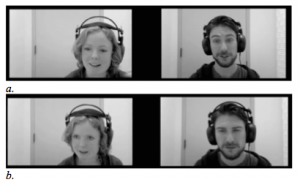The focus in our lab is on collaborative language use, which typically involves getting people to have various conversations or engage in language-mediated tasks in the lab. However, these interactive processes play a role in a type of passive listening as well, when engaged in dialogue comprehension. Dialogue comprehension is what you do when you listen to others have a conversation. While this is an extremely common format of comprehending language, (think eavesdropping on co-workers, the loud couple fighting on the bus, pundits on the news having a discussion or interviewing a guest), it hasn’t been rigorously studied. There are a number of different types, but in general we call people who are doing dialogue comprehension overhearers.
One thing that makes dialogue comprehension interesting is that overhearers pay attention to not only the current speaker, but to any responses the active listener makes. These listener responses are called backchannels, (things like ‘mmhmm‘, ‘uh huh‘, ‘oh‘, as well as nods, smiles, and laughs), and our research has shown that overhearers make use of these backchannels when listening in on a conversation. What’s particularly interesting is that for overhearers, these backchannels are not informative on their own, but cue the overhearers in on the interactive processes happening between the speaker and listener. For example, when listening to a speaker tell a story, another listener saying ‘mmhmm’ leads overhearers to expect the speaker to produce a particular next bit of the story, compared to if the listener had said ‘oh really?’. At other times, overhearers make use of backchannels as indications as to whether a shared opinion is being formed between the speaker and listener, and what the valence of this opinion is. Perceiving a common stance can lead to biased memory of the original talk later, and biased decisions based on this memory.
Lately we have been working with collaborators to extend this paradigm into novel territory, including vicarious word learning in children and learning in class room contexts. These are just some of the possible avenues to consider dialogue comprehension in various aspects of our daily lives, I’m happy to talk with anyone who has an idea of where else this format of comprehension might be relevant!
Related Publications
Tolins, J., & Fox Tree, J. E. (in press). Overhearers use addressee backchannels in dialogue comprehension. Cognitive Science.
Tolins, J., & Fox Tree, J. E. (2014). Addressee backchannels steer narrative development. Journal of Pragmatics, 70, 152-164.
Tolins, J., & Fox Tree, J. E. (under review). Addressee backchannels bias overhearer comprehension when they inform on a shared reality.
